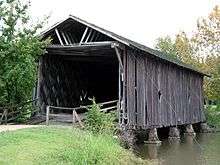Alamuchee-Bellamy Covered Bridge
| Alamuchee-Bellamy CB | |
|---|---|
 The Alamuchee-Bellamy Covered Bridge (1861) moved to the campus of the University of West Alabama in Livingston, Alabama. | |
| Coordinates | 32°35′37″N 88°11′09″W / 32.59374°N 88.18585°WCoordinates: 32°35′37″N 88°11′09″W / 32.59374°N 88.18585°W |
| Carries | pedestrian traffic |
| Crosses | Duck Pond (UWA) |
| Locale | Livingston, Alabama |
| Maintained by | Sumter County Historical Society |
| ID number | 01-60-01 (WGCB) |
| Characteristics | |
| Design | Town Lattice truss |
| Total length | 88 ft (27 m) |
| History | |
| Construction end | 1861 |
The Alamuchee-Bellamy Covered Bridge is a county-owned wooden covered bridge that spans the northeast corner of Duck Pond in Sumter County, Alabama, United States. It is located on the campus of the University of West Alabama behind Reed Hall, which is off Student Union Drive in the city of Livingston.
Built in 1861, the 88-foot (27-meter) bridge is a Town Lattice truss construction over a single span. Its WGCB number is 01-60-01. The Alamuchee-Bellamy Covered Bridge is currently eligible for addition to the National Register of Historic Places. It is one of the oldest covered bridges still existing in Alabama. The bridge is maintained by the Sumter County Historical Society.
History
The Alamuchee-Bellamy Covered Bridge was originally designed and constructed over the Sucarnoochee River by Confederate Army Captain William Alexander Campbell Jones on the main state road leading from Livingston to York, now U.S. Route 11 just south of Livingston. It was built using hand-hewn yellow pine timbers joined together with large wooden pegs. During the American Civil War, the bridge was used as an access route to Mississippi by Confederate forces led by General Nathan Bedford Forrest.
A concrete bridge replaced the Alamuchee-Bellamy Covered Bridge in 1924, and the bridge was moved 5 miles (8 kilometers) south to the old Bellamy-Livingston Road (now Bennett 13 Road, CR 13) over Alamuchee Creek (coordinates 32°31′19.75″N 88°11′12.22″W / 32.5221528°N 88.1867278°W, or 32.522153, -88.186728), soon given the name "Alamuchee Covered Bridge". The bridge remained in service to motor traffic until 1958, when it was once again replaced by a concrete bridge. During that time, a logging truck being used to haul timbers from the construction site accidentally crashed into the bottom of the covered bridge. As a result, the Alamuchee-Bellamy Covered Bridge was permanently closed and left unmaintained.
In 1971, the Sumter County Historical Society came to the rescue and fully restored the damaged bridge. It was moved from Alamuchee Creek back into Livingston and placed over Duck Pond at the University of West Alabama. The Alamuchee-Bellamy Covered Bridge now serves as a campus access route for college students and also attracts visitors from various places to a longstanding piece of history in Sumter County. It has been made wheelchair accessible, and also has lights inside the bridge for nighttime illumination.
Famous Alabama Hanging
Stephen S. Renfroe, known as "Alabama's Outlaw Sheriff," was hanged either from or near the Alamuchee-Bellamy Covered Bridge outside Livingston by locals in July 1886. During that time, the bridge was located over the Sucarnoochee River and not Alamuchee Creek as many sources state.
See also
- List of Alabama covered bridges
- Clarkson–Legg Covered Bridge - bridge in Alabama, also with General Nathan Bedford Forrest
References
- Dale J. Travis Covered Bridges. Alamuchee-Bellamy CB: Credits. Retrieved Aug. 23, 2007.
- Bridges to the Past: Alabama's Covered Bridges. Alamuchee-Bellamy CB: Credits. Retrieved Aug. 23, 2007.
- Alabama Bureau of Tourism & Travel. Alamuchee-Bellamy CB: Credits. Retrieved Aug. 23, 2007.
- The Decatur Daily. Alamuchee-Bellamy CB: Credits. Retrieved Aug. 23, 2007.
- Alabamiana: A Guide to Alabama. Alamuchee-Bellamy CB: Credits. Retrieved Aug. 23, 2007.
- Brad Campbell's Pages of Genealogy & History (Stephen S. Renfroe). Alamuchee-Bellamy CB: Credits. Retrieved Aug. 23, 2007.
- Brad Campbell's Pages of Genealogy & History (Alamuchee-Bellamy Bridge). Alamuchee-Bellamy CB: Credits. Retrieved Aug. 23, 2007.
- Ohio Barns: Covered Bridges. Alamuchee-Bellamy CB: Credits. Retrieved Aug. 23, 2007.
- University of West Alabama. Alamuchee-Bellamy CB: Credits. Retrieved Aug. 23, 2007.
- Bridgehunter.com. Alamuchee-Bellamy CB: Credits. Retrieved Aug. 14, 2013.